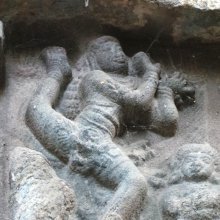Dolahasta, Dolāhasta, Dola-hasta: 2 definitions
Introduction:
Dolahasta means something in Hinduism, Sanskrit. If you want to know the exact meaning, history, etymology or English translation of this term then check out the descriptions on this page. Add your comment or reference to a book if you want to contribute to this summary article.
Images (photo gallery)
In Hinduism
Shilpashastra (iconography)
Source: Shodhganga: The significance of the mūla-beras (śilpa)Dolāhasta (दोलाहस्त) or simply Dolā refers to “dangling” and represents one of the four Elirkai gestures, as defined according to texts dealing with śilpa (arts and crafs), known as śilpaśāstras.—Accordingly, pratimā-lakṣaṇa (body postures of the icons) is comprised of hand gestures (hasta, mudrā or kai-amaiti), stances/poses (āsanas) and inflexions of the body (bhaṅgas). There are thirty-two types of hands [viz., dolāhasta] classified into two major groups known as tolirkai (functional and expressive gestures) and elirkai (graceful posture of the hand).
(Description of Dolā-hasta): This gesture has the appearance of a broken and hanging branch of a tree. The hand is held in a sharp downward slope from the shoulder. It is also known as lola-kara or lamba-kara. The fingers are held in a pallava-hasta.

Shilpashastra (शिल्पशास्त्र, śilpaśāstra) represents the ancient Indian science (shastra) of creative arts (shilpa) such as sculpture, iconography and painting. Closely related to Vastushastra (architecture), they often share the same literature.
Natyashastra (theatrics and dramaturgy)
Source: Shodhganga: Elements of Art and Architecture in the Trtiyakhanda of the Visnudharmottarapurana (natya)Dolāhasta (दोलाहस्त) or simply Dolā refers to one of the thirteen Saṃyuktahastas or “combined hand gestures” (in Indian Dramas), according to the Viṣṇudharmottarapurāṇa, an ancient Sanskrit text which (being encyclopedic in nature) deals with a variety of cultural topics such as arts, architecture, music, grammar and astronomy.—The hasta-mudrās (lit. “hand-gestures”) are very essential to denote some particular action or state in dancing and these mudrās are formed with the help of hands and fingers. In the Viṣṇudharmottarapurāṇa, thirteen kinds of saṃyuktahastas (“dancing postures made by combined hands”) are mentioned. e.g., dolāhasta.

Natyashastra (नाट्यशास्त्र, nāṭyaśāstra) refers to both the ancient Indian tradition (shastra) of performing arts, (natya—theatrics, drama, dance, music), as well as the name of a Sanskrit work dealing with these subjects. It also teaches the rules for composing Dramatic plays (nataka), construction and performance of Theater, and Poetic works (kavya).
See also (Relevant definitions)
Partial matches: Dola, Hasta, Tola.
Full-text (+17): Valli, Dola, Dharmasastha, Rush, Intoxication, Bhavani Ambal, Antal, Govardanambikai, Ayyappan, Lakshmi, Grief, Meditation, Kurmavatara, Charity, Minakshi, Edible, Emotion, Rangamannar, Muthukumara, Ganapati.
Relevant text
Search found 2 books and stories containing Dolahasta, Dolāhasta, Dola-hasta, Dolā-hasta; (plurals include: Dolahastas, Dolāhastas, hastas). You can also click to the full overview containing English textual excerpts. Below are direct links for the most relevant articles:
The Religion and Philosophy of Tevaram (Thevaram) (by M. A. Dorai Rangaswamy)
Chapter 4.3 - (b) The seven Tandava Dances of Shiva < [Volume 2 - Nampi Arurar and Mythology]
Natyashastra (English) (by Bharata-muni)
